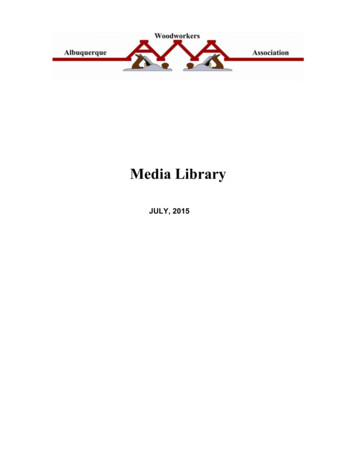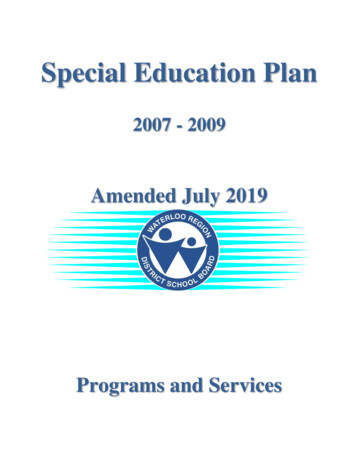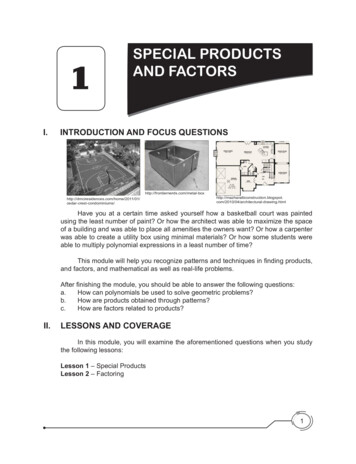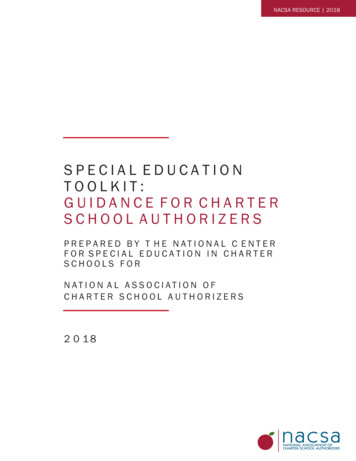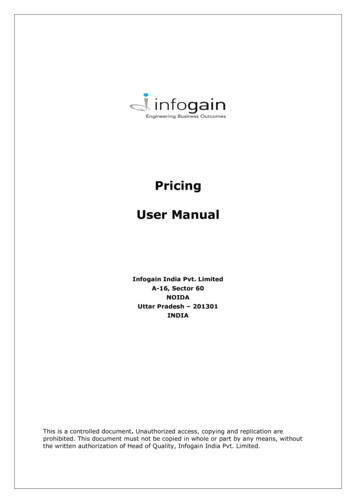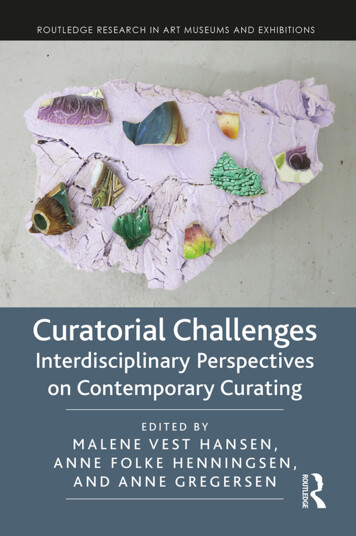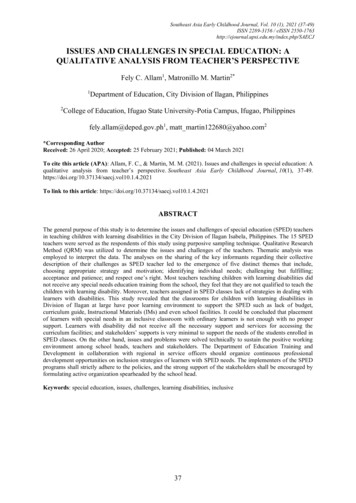
Transcription
Southeast Asia Early Childhood Journal, Vol. 10 (1), 2021 (37-49)ISSN 2289-3156 / eISSN CJISSUES AND CHALLENGES IN SPECIAL EDUCATION: AQUALITATIVE ANALYSIS FROM TEACHER’S PERSPECTIVEFely C. Allam1, Matronillo M. Martin2*12Department of Education, City Division of Ilagan, PhilippinesCollege of Education, Ifugao State University-Potia Campus, Ifugao, Philippinesfely.allam@deped.gov.ph1, matt martin122680@yahoo.com2*Corresponding AuthorReceived: 26 April 2020; Accepted: 25 February 2021; Published: 04 March 2021To cite this article (APA): Allam, F. C., & Martin, M. M. (2021). Issues and challenges in special education: Aqualitative analysis from teacher’s perspective. Southeast Asia Early Childhood Journal, 10(1), 1To link to this article: ACTThe general purpose of this study is to determine the issues and challenges of special education (SPED) teachersin teaching children with learning disabilities in the City Division of Ilagan Isabela, Philippines. The 15 SPEDteachers were served as the respondents of this study using purposive sampling technique. Qualitative ResearchMethod (QRM) was utilized to determine the issues and challenges of the teachers. Thematic analysis wasemployed to interpret the data. The analyses on the sharing of the key informants regarding their collectivedescription of their challenges as SPED teacher led to the emergence of five distinct themes that include,choosing appropriate strategy and motivation; identifying individual needs; challenging but fulfilling;acceptance and patience; and respect one’s right. Most teachers teaching children with learning disabilities didnot receive any special needs education training from the school, they feel that they are not qualified to teach thechildren with learning disability. Moreover, teachers assigned in SPED classes lack of strategies in dealing withlearners with disabilities. This study revealed that the classrooms for children with learning disabilities inDivision of Ilagan at large have poor learning environment to support the SPED such as lack of budget,curriculum guide, Instructional Materials (IMs) and even school facilities. It could be concluded that placementof learners with special needs in an inclusive classroom with ordinary learners is not enough with no propersupport. Learners with disability did not receive all the necessary support and services for accessing thecurriculum facilities; and stakeholders’ supports is very minimal to support the needs of the students enrolled inSPED classes. On the other hand, issues and problems were solved technically to sustain the positive workingenvironment among school heads, teachers and stakeholders. The Department of Education Training andDevelopment in collaboration with regional in service officers should organize continuous professionaldevelopment opportunities on inclusion strategies of learners with SPED needs. The implementers of the SPEDprograms shall strictly adhere to the policies, and the strong support of the stakeholders shall be encouraged byformulating active organization spearheaded by the school head.Keywords: special education, issues, challenges, learning disabilities, inclusive37
Southeast Asia Early Childhood Journal, Vol. 10 (1), 2021 (37-49)ISSN 2289-3156 / eISSN CJINTRODUCTIONBackground of the StudyEducation of learners with special needs has come an extensive and lengthy way; it can be ina method from special education (SPED) to integrated education and it as process fromintegrated education to inclusive education. Despite the prop-up by a number of guidelines,policies and programs from time to time to speed up the bound of all the efforts made in thisdirection the regular schools with inclusive orientation face many barriers, roadblocks,impediments and challenges.However, SPED is currently a topical subject that is widely discussed and deliberatedupon in the field of education, Philippines included. It has invariably been referred to as partof the global education for all agenda as a new education paradigm and as an educationalreform goals to make our societies inclusive. The same is accepted in Philippines; however,the aspect of education for all is not effectively implemented despite of having policies andlegal framework that advocate education for all specially in the implementation of SPEDclasses.The Declaration of the Rights of the Child adopted by the United Nations GeneralAssembly in 1959, affirmed that mankind owes to the child the best it has to give. One of theprinciples concerned with the education of children with special needs runs:“The child who is physically, mentally or visually handicapped shallbe given the special treatment, education that are required of his particularcondition.”Moreover, Republic Act Nos. 3562 and 5250 were approved on June 13, 1968respectively, these Acts provided that teachers, administrators, and supervisors of SPEDshould be trained by the Department of Education and impoverished.Sarason (2015) indicated that one of the main purposes of the educational process isto “produce responsible, self-sufficient citizens who possess the self-esteem, initiative, skillsand wisdom to continue individual growth and pursue knowledge.” Such an idea of educationbrings to light initiatives to promote the self-determination of students with disabilities.Enhancing students with disabilities’ self-determined behavior characteristics hasbeen a considerable element of policy, research, and curriculum standards and teachingpractices to help students to have a smooth and successful transition to postsecondary settings(Cho et al., 2013).The education should enhance teachers who teach children with learning disabilityand also create awareness in the society to accept children with special educational needs.Therefore, there is a need to introduce comprehensive special needs education in all teacherprofessional development-programs.Teachers and administrators are perceived to be integral to the implementation ofinclusive education. They played a vital role in the successful implementation of inclusiveeducation as they are viewed as linchpins in the process of including students with disabilities38
Southeast Asia Early Childhood Journal, Vol. 10 (1), 2021 (37-49)ISSN 2289-3156 / eISSN CJinto regular classes. This cannot be achieved if awareness and attitudes towards inclusiveeducation has not been practiced and developed (Dalonos, 2013).Given the all citations, it is very important to know the different challenges faced bythe teachers in handling classes in the SPED. Hence, this study addressed the issue ofchildren with learning disabilities by exploring the challenges and challenges faced by SPEDteachers who teach children with learning disability and how they try to overcome thesechallenges. There have been many problems in teaching children with learning disability inthe City of Ilagan. Local teachers in most of the primary schools in the division of Ilagan lacktraining in special needs education for children with learning disability. Despite the “PrimaryEducation Development Plan” (PEDP), that ensures education for all, the overall quality ofprimary education in Ilagan, City Philippines remains generally poor particularly in schoolsfor children with learning disability.Purpose of the StudyThe general purpose of this study is to determine the issues and challenges of SPED teachersin teaching children with learning disabilities in the City Division of Ilagan Isabela,Philippines. The empirical investigation is guided by the following objectives: (i) to seeteachers’ challenges in teaching students with learning disabilities; (ii) to find out theapproach and methods of teaching used by teachers when teaching children enrolled inSPED; and (iii) to find out to what extent the administrators and parents of children withlearning disability collaborate with special needs education teachers.Theoretical FrameworkThe scientific management theory and classical theory fitted in this study. In terms of theimplementation of SPED, it focused on improving the efficiency of each individual in theorganization. The major emphasis is on increasing the production through the use of intensivetechnology, and the human beings are just considered as adjuncts to machines in theperformance of routine tasks. Besides, the scientific management theory basicallyencompasses the work performed on the production floor as these tasks are quite differentfrom the other tasks performed within the organization. Such as, these are repetitive in nature,and the individual workers performing their daily activities are divided into a large number ofcyclical repetition of same or closely related activities. Also, these activities do not requirethe individual worker to exercise complex-problem solving activity. Therefore, moreattention is required to be imposed on the standardization of working methods and hence thescientific management theory laid emphasis on this aspect.39
Southeast Asia Early Childhood Journal, Vol. 10 (1), 2021 (37-49)ISSN 2289-3156 / eISSN CJFigure 1. Paradigm showing the relationship between the variables considered in this study.In terms of administration and supervision, teacher responsibilities regular classroomteachers view the learner as a total person, assess the behavioral signs ofdisorders/difficulties, provide varied activities for a wide range of individual differences,provide a setting for, and expect achievement of the learner, provide strategies that help thelearner develop concepts meaningful to himself and provide first-hand challenges, obtainassistance in the form of constructive consultation and specialized materials and equipment,and confer regularly with the SPED teacher.In order to establish good SPED classes, SPED coordinator plays a vital role. SPEDcoordinators shall maintain all school records for SPED learners, assist in the recruitment ofprospective learners and SPED teachers, assist/initiate/organize training programs for SPEDinnovate programs and projects for both learners and teachers, monitor/evaluate classroominstruction and related activities in SPED, integrate and implement new and existing policiesand guidelines of the SPED Program, demonstrate leadership in resourcing appropriateeducational facilities/instructional aids.The concepts and ideas served as the guiding wisdom in the development of thisresearch study which is reflected in the paradigm of the study. The paradigm would serve asthe backbone of this present investigation.The researchers conducted a research to know prevailing issues of the SPED and towhat extent are these experienced by teachers in terms of teachers; instruction support; andcurriculum. As seen in figure 1 after identifying the issues, problems and challenges in theSPED classes encountered by the teachers, the proposed action plan in order to enhance theSPED would be provided.40
Southeast Asia Early Childhood Journal, Vol. 10 (1), 2021 (37-49)ISSN 2289-3156 / eISSN CJMETHODOLOGYThis study used a qualitative research design. The main objective was to find the challengesfaced by teachers when teaching in SPED classes and how they try to overcome them. Inorder to get information from the special needs education teachers, a descriptive researchdesign was used to provide answers to the questions associated with a particular researchproblem. Since descriptive research is primarily concerned with finding out what is in thefield, it used this study as a suitable way to gather vital information regarding the currentstatus of the problem which was the challenges faced by teachers when teaching learners withdevelopmental disability and how they try to overcome these challenges. This design greatlyhelped me to increase the knowledge about the challenges faced by teachers.The study was conducted to the public elementary schools with SPED learning centerof Schools Division of City of Ilagan. Selected SPED teachers of City Division of Ilaganwere served as the sample of this study. Respondents were selected using purposive samplingtechnique.The main target was SPED teachers, and not regular teachers. Therefore, the onecriterion of choosing informants was based on the fact that only special needs educationteachers were wanted for the interview. Another criterion for choosing the informants was thenumber of years a special needs education teacher had been teaching children with learnerswith disability. For this study it was decided that the special needs teachers, who had beenworking with children with learners for many years, were a good choice to answer theresearch questions.A total of 15 teachers from five different elementary schools were interviewed. Thestudy was conducted during the School Year 2019-2020. Permission to conduct the surveywith the SPED teachers of City Division of Ilagan was sought by the researchers from theSchools Division Superintendent. Upon the approval of the request by Schools DivisionSuperintendent, the researchers personally administered the interview among the targetrespondents. To allow collection of detailed information from the teachers about how theyteach students with learning disabilities and the challenges faced by teachers in the differentschools of City Division of Ilagan, interview method was seen suitable.An interview guide questionnaire was utilized as the primary data gatheringinstrument for the study. The interview guide was designed by the researcher based onreadings of related literature and studies on concepts of challenges and issues in SPED in thecountry. An interview was carried out with every teacher selected to participate in the study.The time arranged for an interview was approximately 25-30 minutes for every teacher. Theinterview questions were formulated on the basis of the main research questions and subquestions. The research questions were translated from English to Filipino if necessary, andthe medium of instruction in all SPED classes. For this reason, all respondents wereinterviewed in Filipino for better communication between the interviewer and theinterviewee.41
Southeast Asia Early Childhood Journal, Vol. 10 (1), 2021 (37-49)ISSN 2289-3156 / eISSN CJRESULTS AND DISCUSSIONThe analyses of the empirical data yielded five themes on the notable challenges faced inSPED. The analyses on the sharing of the key informants regarding their collectivedescription of their challenges as SPED teacher led to the emergence of five distinct themesthat include; (i) choosing appropriate strategy and motivation; (ii) identifying individualneeds; (iii) challenging but fulfilling; (iv) acceptance and patience; and (v) respect one’s rightas shown in Figure 2.Choosing appropriatestrategy and motivation.Acceptance andpatience.THEMESRespect one’s right.Identifying individualneeds.Challenging butfulfilling.Figure 2. Themes to challenges of teachers in the implementation of SPEDChoosing Appropriate Strategy and MotivationThe learner’s motivation is mostly regarded as a central condition for successful learning.However, other factors like intelligence, previous knowledge and interest play an importantrole as well. In the context of teaching SPED classes, strategies should be considered.Motivation and applicable strategies in teaching as an activating orientation to a target statuswhich is regarded as positive in teaching-learning situation (Rheinberg, 2010).Based from the interview, motivation is a driving force to act in order to achievesomething as articulated by the respondents during the interview:Teacher Cactus: “In handling regular classes, it is very easy to initiateteaching strategies, but if you are teaching learners with disabilities, you havea limited teaching approach. Besides, it is very hard to motivate the learnerswith disabilities.Based on the statement of Teacher Cactus, the learner’s motivation is mostly regardedas central condition for successful learning. However, other factors like the status andlearning difficulties may affect the learners’ learning. Hence, the interest among the learnerswith special needs play an important role as well.42
Southeast Asia Early Childhood Journal, Vol. 10 (1), 2021 (37-49)ISSN 2289-3156 / eISSN CJBasically, what is problematic about learning and knowledge-gaining processes isintegrating strategies in teaching learners with disabilities. It also hard to introduce newknowledge to them since they have their own field of interest (Friedrich & Mandl, 2012).It clearly depicted in the statement of Teacher Cactus that, “ but if you are teachinglearners with disabilities, you have a limited teaching approach.” This statement wassupported by one of the key informants that:Teacher Champaca: “I had a positive experienced in teaching specialeducation. Being a special education teacher, in terms of teaching strategies,you should not think of it but, you should apply the applicable techniques ifyou are in the actual teaching situation. I have encountered problem about itand I have very limited teaching approaches in handling special educationclasses.Necessarily, school for learners with special needs has to be the place where studentslearn how to learn and thus successfully acquire learning strategy. It means that thestatements of Teacher Champaca and Teacher Camia contribute a development of thelearners in spite of their learning disabilities. This corroborates with the study of Aquino et al.(2019) that balance and holistic development of the children should be ensured.According to Nachiappan et al. (2018), as a way to overcome the problem of teachersin teaching and learning, practical teacher must have wide knowledge through extensivereading in order to implement the various activities and more interesting. This was testifiedby one of the teachers that,Teacher Camia: “Be positive and try your best to initiate best strategyto be employed in teaching learners with special needs.Moreover, the responses of the key informants supported the study of Tough (2015)that current pedagogical research focuses on student’s learning processes in general and alsoon which learning strategies students should be introduced to enable effective learning.Also, Teacher Champaca, one of the key informants mentioned that “Lack ofavailable and updated Teachers guide and curriculum guide and seminars among teachers”is one of the problems she encountered. This means that in the conflict between impartingknowledge and developing the students’ learning competence school education puts the focuson the materials needed in teaching.The study revealed that limited special needs education teachers in Division of Ilaganwas a problem. It was found that the special needs education teachers in some schools werenot professionally educated. They have limited strategies in dealing with the learners withspecial needs. It was also revealed that the colleges that provide special needs educations forteachers were few compared to ordinary education colleges. However, these cannot produceenough teachers to teach special needs education schools in the entire division.Given all the citation and testimonies of the respondent, teaching strategies andmotivation are important elements in teaching learners with special needs. Thus, it isimportant for teachers to examine the learning disabilities among students as early as possibleto know what are the appropriate strategy and motivation to be used in teaching.43
Southeast Asia Early Childhood Journal, Vol. 10 (1), 2021 (37-49)ISSN 2289-3156 / eISSN CJIdentifying Individual NeedsRecognizing individual differences of the learners is a basic concept when teachers prepare toteach. It is a fundamental assumption of strategic teaching and learning that what we chooseto teach in the classroom should be an interaction of what we know about the variables ofinstruction, learning, achievement, and contextual factors. This assumption has driven ourquest as individuals and groups to develop an instructional framework (Jones et al., 2017).In an interview, Teacher Carnation mentioned: “I teach learners with differentdisabilities in a day. It is very hard to identify their needs.” It is clearly reflected in thestatement of Teacher Carnation that “ teaching learners with special needs is very hardbecause they have their individual needs.” This means that in handling Learners with SpecialNeeds (LSNs), individual needs must be considered. Fairness treatment should also be givento all the students. This statement supported to the result of the study of Evans (2015) thatpaying attention to the needs of students from diverse groups within your course designincluding an equality analysis/impact assessment processes in your course development is auseful way of ensuring that you give due consideration to inclusivity and accessibility. This isalso in line with the response of Teacher Pearl during the interview that:“In instruction for me, it is very difficult to prepare because of the lack ofbudget and sometimes because of over workload given to us needed to teachour learners, we need to prepare different activities depending on the natureof needs of our students. Truly, it is hard to teach students with variedlearning needs.”The statement of Teacher Pearl implicates that all teachers need to have knowledgeand wider understanding of the minimum core elements in order to apply them in planning,delivering and assessing inclusive teaching and learning and to support learners adequatelywith their skills in these areas with different learning needs. Developing and improvingminimum core skills enables the SPED teacher to consider the best way to teach and supportthe development of the skills of the learners with special needs.Moreover, individual needs among the learners with special needs shall beconsidered. This condition supported by some of the key informants that:Teacher Sampaguita: “ in almost 23 years now, I can say that I canmake impossible things to become possible like letting join them activities withregular students even they have their learning disabilities. Besides, you needto consider their individual needs example by joining them to participate indrum and lyre and try to compete with the regular students.”Based from the statements of Teacher Sampaguita, she encountered the samechallenges in handling students with disabilities. This means that teachers in SPEDencountered difficulties if they have limited skills in handling the students with special needs.Moreover, it is important that teachers especially early childhood educators shouldunderstand parental involvement and recognize its positive effects to the teaching andlearning process (Bartolome et al., 2020). This was testified by one of the teachers that,44
Southeast Asia Early Childhood Journal, Vol. 10 (1), 2021 (37-49)ISSN 2289-3156 / eISSN CJTeacher Daisy: “I handle them very difficult because of theirindividual needs. You need to exert more effort to cater the needs of thestudents with special needs. Likewise, the special education teachers mustrecognize the parental involvement in order to help their children developtheir potential.”Challenging but FulfillingDouglas and Travers (2012) recognized that IEPs can assist students with special educationalneeds to gain access to an appropriate education in spite of their learning disabilities. Thiswas supported by Teacher Gold that: “It is very challenging to teach learners with specialneeds. Their performance would be the reflection of your achievement.” This means that asSPED teacher, it is very important to help the students develop their potential in spite of theirlearning difficulties. Teacher considers different factors that may help the students grow andenhance their skills if they have. These statements were also supported by some of the keyinformants that:Teacher Santan: “ And as a teacher we should not stop aiming for thedevelopment of the students, we need to help them grow and enhance theirskills, not only for our daily undertaking in the school, promotion but for ourcontribution to the students on how they cope with their learning disabilities.”Teacher Santan emphasized that as SPED teacher we need to extend help to thelearners with special needs not for the promotion. It also stressed out that the teacher’scontribution to the students on how they cope with their learning disabilities is veryimportant. This implies that teachers’ effort and skills play a very important role in moldingand shaping the learners’ abilities and potential in school despite their difficulties.The result of the study implies that there are some SPED teachers who are satisfied inteaching students with learning disabilities. In this belief, understanding learning disabilitiesor challenges that may impede a student’s ability to learn is vital to providing the bestpossible classroom environment. Students with learning disabilities are no less intelligentthan the average student and often require very simple accommodations to maximize theirlearning experience.Acceptance and PatienceIn an interview, Teacher Camia mentioned:"My experience especially deaf, they had no medical certificate, I could evenhave observed other kinds of disability but I didn't have the right to tell theirparents because they might be embarrassed if I will advise their children toundergo check-up. It was very difficult because if I will give feedbacks andcomments on them, their parents would not let their children to attend studiesanymore. So, acceptance of the parents must be considered. In that situation,as a teacher, I need to be more patience in handling this kind of situation."45
Southeast Asia Early Childhood Journal, Vol. 10 (1), 2021 (37-49)ISSN 2289-3156 / eISSN CJIt is clearly stated based on the statement of Teacher Camia that “ It was verydifficult because if I will give feedbacks and comments on them, their parents would not lettheir children to attend studies anymore. So, acceptance of the parents must be considered”that in her line, through the feedbacks and comments of the SPED teachers, parents will beimmediately embarrassed. This implies that the value of acceptance must be intensified andthe essence of working as a team or partner in helping the students to be fully developed shallbe considered.Additionally, acceptance must be given value in handling SPED classes. Teachers andparents discussed the consequences and other significances if the parents refused to acceptthe learning disabilities of their children. As one of the SPED teacher Carnation confirmedthat: “Our school head, some of my co-teachers and parents are very supportive to thespecial education program. But, based on my challenges, some of the parents are deniable;they refused to accept the reality that their children have learning difficulties. In this case, asspecial education teacher, you need to be patience and considerate.” It is clearly reflected onthe statement of Teacher Carnation that “ some of the parents are deniable, they refused toaccept the reality that their children have learning difficulties” that in her line, there are stillparents who never accept the situation of their children with learning disabilities. This impliesthat even the school head and other teacher extend support to the SPED program if parentsrefuse to accept the reality, the ultimate goal of the SPED program would not probablyrealize.Respect Student’s RightSince then, the right to education has been widely recognized and developed by a number ofinternational normative instruments elaborated by the United Nations, thus education is not aprivilege. It is a human right (Matkoba, 2018). Based on this, Teacher Gold mentioned that,“No curriculum given for ID, AU and other learners with disabilities. Our curriculum isbased on K-12 but we often modify it base in our learning needs because it is the right of thestudents to learn and study.” The statement of Teacher Gold implies that in the country theright of the students to access quality education shall be given to them regardless of theirstatus. It is very essential to help the students with disabilities to access education with thehelp of the teachers. This is being supported that, the state shall protect and promote the rightof all the citizens to quality education at all levels and shall take appropriate steps to makesuch education accessible to all (Article XIV, Section 1).Moreover, it is very important to consider the rights of the learners. This was stressedout by Yusof and Ismail (2020) that the acceptance of special needs children in privateand public kindergartens is under consideration and following the rules and regulations.Also, despite the insufficient resources and other materials in teaching students withdisabilities, the teacher finds possible ways to teach them. The teacher has the ability tomodify some parts of the curriculum in the regular classes to fit the curriculum of the SPEDclasses. Teacher Tulips stressed out that, “We encountered lack of instructional materials;the sample IMs were not provided that will be served as our basis to determine whatappropriate skills and competencies to be taught to our students. So, as a teacher, I need todownload IMs and activity sheets in the Learning Management Resource System since thechildren have right for education.”46
Southeast Asia Early Childhood Journal, Vol. 10 (1), 2021 (37-49)ISSN 2289-3156 / eISSN 2550-1763http://ejournal.
status of the problem which was the challenges faced by teachers when teaching learners with developmental disability and how they try to overcome these challenges. This design greatly helped me to increase the knowledge about the challenges faced by teachers. The study was conducted to the public elementary schools with SPED learning center

